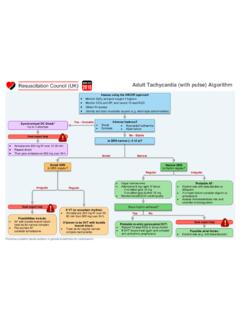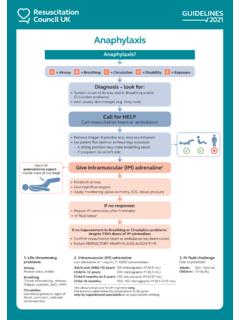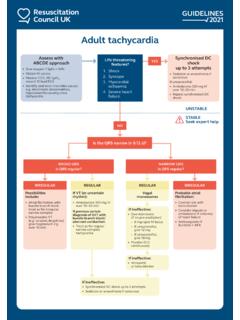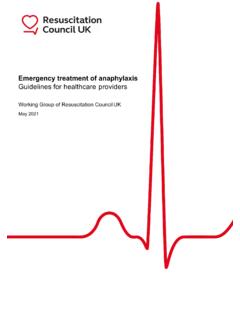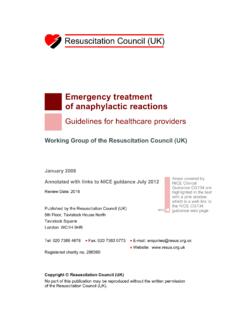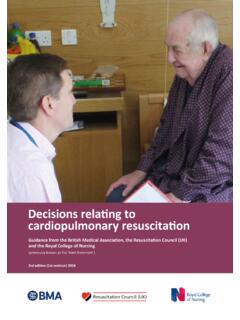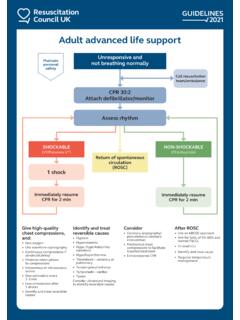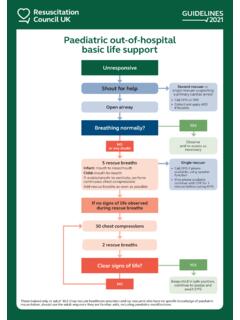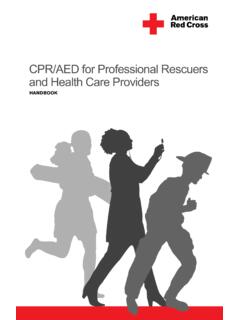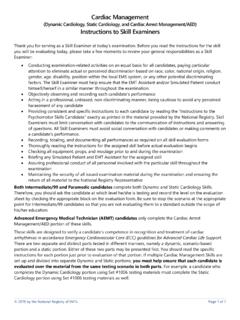Transcription of Cardiopulmonary resuscitation, automated defibrillators ...
1 Cardiopulmonary resuscitation, automated defibrillators and the law1 Cardiopulmonary resuscitation, automated defibrillators and the lawbyResuscitation Council UK April 20182 ContentsHeadline messages 3 Executive summary 4 Introduction 6 Key facts about resuscitation 7 Key facts about automated external defibrillators 8 Possible grounds for a claim for damages 9A claim for assault and/or battery 10 Understanding the terms 10 How is this relevant to resuscitation? 10 Consent for treatment: the position of health professionals 10 Can these defences apply to other rescuers?
2 11 The Social Action Responsibility and Heroism Act 2015 11 The Mental Capacity Act (England and Wales) 2005 12 Adults with Incapacity Act (Scotland) 2000 13 The Mental Capacity Act (Northern Ireland) 2016 13A claim for negligence 14 Who has a duty of care? 14 What about volunteers? 14 When intervention could cause harm 14 The standard of care 14 How the law applies to children 16 Liability of third parties 16 How to avoid liability 17 Responsibility to provide an AED in a public place 19 Where are AEDs currently provided? 19 Potential liability 19 Assessing the risk 19 Cost and training considerations 19 Acknowledgements 20In this booklet, the term bystander means a person who is present and able to help when someonecollapses, or is found collapsed, as a result of a possible sudden cardiac arrest.
3 Other terms such aswitness, passer-by, family member, rescuer or first aider may apply equally well in certain resuscitation, automated defibrillators and the law3Up to 60,000 people die each year in the UK from sudden cardiac arrest (SCA). Fewer than 1 person in 10 survives if SCA occurs out of hospital. Cardiopulmonary resuscitation and the use of an automated external defibrillator significantly improve survival. Both can be delivered by untrained members of the public. Acting to help someone who has suffered SCA will greatly improve their chance of survival.
4 The courts have always looked benevolently on those who have gone to the assistance of European Heart Journal (2001) 22, 1374 1450 RESUSCITATION TO RECOVERY A National Framework to improve care of people with out-of-hospital315246 Headline messagesCardiopulmonary resuscitation, automated defibrillators and the law4 The true annual number of deaths from sudden cardiac arrests (SCA) in the UK is currently unknown, but based on European data it is estimated to be around 60,000 per However, we do know for sure that in England the ambulance service attempts resuscitation in around 30,000 cases Unfortunately, at present, fewer than 1 person in 10 survives when the SCA occurs out of We need more bystanders to start immediate Cardiopulmonary resuscitation (CPR) in cases of SCA to improve and the use of an automated external defibrillator (AED) can significantly increase survival chances in these circumstances if performed promptly.
5 AEDs are often provided in public places and can be safely used by untrained members of the public while waiting for an ambulance. The likelihood of causing harm by performing CPR or using an AED is very small indeed. Nevertheless, there has been some concern that should an attempt to resuscitate someone having a suspected SCA result in harm, a legal claim could be brought against the rescuer . To date, there has been no reported successful claim to this effect. There are no statutory laws covering resuscitation but a potential liability could arise if a civil claim were brought by the victim, or their family, against someone on the grounds that intervention occurred without their consent and so constituted an assault and/or professional medical practice, there are two defences available to healthcare professionals.
6 Executive summaryThey include implied consent (the assumption that if someone were conscious and able to make a decision, they would consent to the procedure) and necessity (that the treatment is given in the best interests of the patient). While the defence of implied consent may not be as clear-cut if the rescuer isn t medically qualified, the defence of necessity may be available, provided the rescuer acts reasonably in the circumstances. For instance, it would be reasonable to carry out CPR and use an AED if no healthcare professionals were 5 of the Mental Capacity Act (England and Wales) 2005, which applies to people aged 16 and over, may also add weight to this defence.
7 It suggests that if a passer-by goes to help someone believed to be having a cardiac arrest, they are not committing battery if they reasonably believe the person they are trying to help isn t mentally capable of giving consent for CPR and use of an AED, and that they believe it would be in the person s best interests to try to resuscitate European Heart Journal (2001) 22, 1374 1450 RESUSCITATION TO RECOVERY A National Framework to improve care of people with out-of-hospitalCardiopulmonary resuscitation, automated defibrillators and the law5A claim for negligence could be brought if it could be shown that a duty of care had been breached, leading to harm.
8 In the UK, there is no legal obligation for others to help a person in need of resuscitation, provided they were not the cause of the person needing help. However, there are circumstances in which certain professionals, and people who have a particular relationship with the collapsed person, would be considered to have a duty of care. Also, once a bystander volunteers to help, they are then considered to have a duty of care to assist the person as far as they are who attempts resuscitation would only be legally liable if it could be shown that the intervention had left a person in a worse position than they would have been in had no action been taken.
9 In the case of a cardiac arrest, this would be virtually impossible, since without intervention death is inevitable. Added to that, an AED will only deliver shocks if it detects a pattern consistent with a cardiac arrest. Someone could potentially be left worse off if CPR were carried out inappropriately, but this is highly unlikely. In this case, it would have to be shown that the standard of care were to blame and this would be judged according to the rescuer s training level. Third parties, such as first aid trainers, or organisations that provide training, maintain resuscitation equipment or administer the system under which rescuers operate, could also be potentially held liable.
10 However, a claim would only be successful if the training were below standard, or equipment had not been correctly maintained, leading directly to is no UK legislation stipulating that AEDs must be provided in public areas, so not providing them could not result in a claim under statutory law. However, since their introduction, the use of AEDs by laypeople has been widely recommended in international resuscitation guidelines. This has given rise to the concern that failing to provide an AED might lead to a claim for negligence under common law if a member of the public were to suffer a cardiac arrest on the premises.
